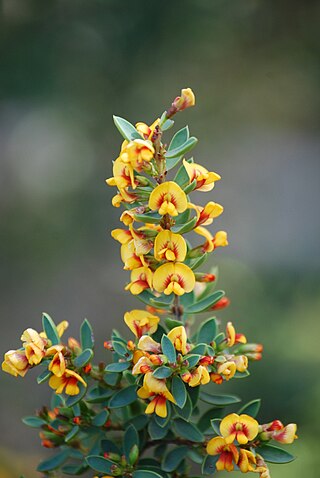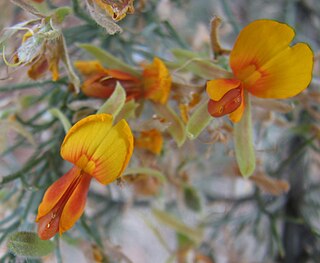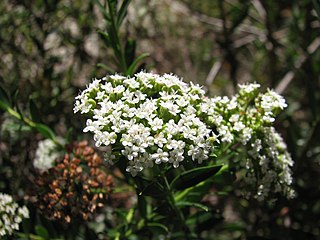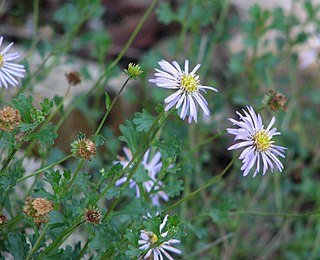
Eutaxia is a genus of the family Fabaceae. They are native to Australia. Most are endemic to the Southwest Botanical Province of Western Australia, but a few are distributed throughout mainland Australia. The chromosome number of Eutaxia species is typically 2n = 14 or 16.

Darwinia, sometimes commonly known as mountain bells or simply bells, is a genus of about 70 species of evergreen shrubs in the family Myrtaceae, endemic to southeastern and southwestern Australia. The majority are native to southern Western Australia, but a few species occur in South Australia, New South Wales and Victoria. The genus was named in honour of Erasmus Darwin, grandfather of Charles Darwin by Edward Rudge in 1816. Most darwinias grow to a height of between 0.2 and 3 m, and many are prostrate shrubs. Most have small, simple leaves and the flowers are often grouped together, each flower with five red, white or greenish petals and ten stamens. In many species, the flowers are surrounded by large, colourful bracts, giving rise to their common names.

Commersonia is a genus of twenty-five species of flowering plants in the family Malvaceae. Plants in this genus are shrubs or trees, occurring from Indochina to Australia and have stems, leaves and flowers covered with star-like hairs. The leaves are simple, often with irregularly-toothed edges, the flowers bisexual with five sepals, five petals and five stamens and the fruit a capsule with five valves. The genus underwent a revision in 2011 and some species were separated from Commersonia, others were added from Rulingia.

Chamelaucium, also known as waxflower, is a genus of shrubs endemic to south western Western Australia. They belong to the myrtle family Myrtaceae and have flowers similar to those of the tea-trees (Leptospermum). The most well-known species is the Geraldton wax, Chamelaucium uncinatum, which is cultivated widely for its large attractive flowers.

Gastrolobium is a genus of flowering plants in the family Fabaceae. There are over 100 species in this genus, and all but two are native to the south west region of Western Australia.

Mirbelia is a plant genus belonging to the family Fabaceae and is endemic to Australia, occurring in every mainland state except South Australia. Plants in the genus Mirbelia are prickly, perennial shrubs with simple, sometimes sharply-pointed leaves, or the leaves absent. The flowers are arranged singly or in groups in leaf axils or on the ends of branches, the sepals joined at the base with five teeth. The petals are usually red, orange, purplish or bluish and the fruit is an inflated pod.

Thomasia is a genus of thirty-one species of flowering plants in the family Malvaceae. Plants in this genus are small shrubs that are endemic to the south-west of Western Australia, apart from T. petalocalyx that is native to Victoria and South Australia. The leaves are simple with leaf-like stipules at the base of the petiole, the flowers bisexual with five papery, petal-like sepals, usually five petals and five stamens opposite the petals. The fruit is a capsule covered with star-like hairs.

Jacksonia is a genus of about 73 species of mostly leafless, broom-like shrubs or small trees in the flowering plant family Fabaceae. The genus is endemic to Australia and species occur in a range of habitats in all Australian states except Victoria, South Australia and Tasmania.

Platysace is a genus of woody perennial herbs and subshrubs in the family Apiaceae. The genus is endemic to Australia.

Hypocalymma is a genus of evergreen shrubs in the myrtle family Myrtaceae described as a genus in 1840. The entire genus is endemic to southern Western Australia.

Guichenotia is a genus of 17 species of flowering plants in the family Malvaceae that is endemic to the south west of Western Australia. Plants in the genus Guichenotia are shrubs with simple, linear to oblong leaves with leaf-like stipules at the base of the petiole, the flowers bisexual with three bracteoles at the base of the sepals, and five petal-like sepals, the petals sometimes absent. The fruit is a capsule usually containing 15 seeds.

Trachymene is a genus of herbaceous plants in the family Araliaceae. The species are native to Australia, Malesia, New Caledonia and Fiji.

Calytrix is a genus of shrubs in the family Myrtaceae described as a genus in 1806. They are commonly known as starflowers. Calytrix are endemic to Australia, occurring in the.

Calotis is a genus of herbs or small shrubs in the daisy family Asteraceae. Most of the species are native to Australia, while two occur in Asia.

Sphaerolobium is a genus of flowering plants in the family Fabaceae and is endemic to Australia, occurring in all states and territories except the Northern Territory. Species of Sphaerolobium are erect shrubs, usually with rush-like stems and yellow or red flowers similar to others in the family.
Millotia is a genus of small annual herbs in the tribe Gnaphalieae within the family Asteraceae.

Asteridea is a genus of flowering plants in the family Asteraceae. Evidence suggests that the genus, Asteridea, is monophyletic.

Microcybe multiflora is a small shrub in the family Rutaceae. The species is endemic to Australia. It usually grows to between 0.2 and 1 metre high and produces cream to yellow flowers.

Conothamnus is a genus of flowering plants in the family Myrtaceae and is endemic to the south-west of Western Australia. They are woody shrubs similar to melaleucas but differ in that their leaves are usually arranged in opposite pairs and the maximum number of seeds per fruit is three.

Lawrencia squamata is a species of plant in the mallow family, Malvaceae. It is endemic to Australia and occurs in all Australian states.



















